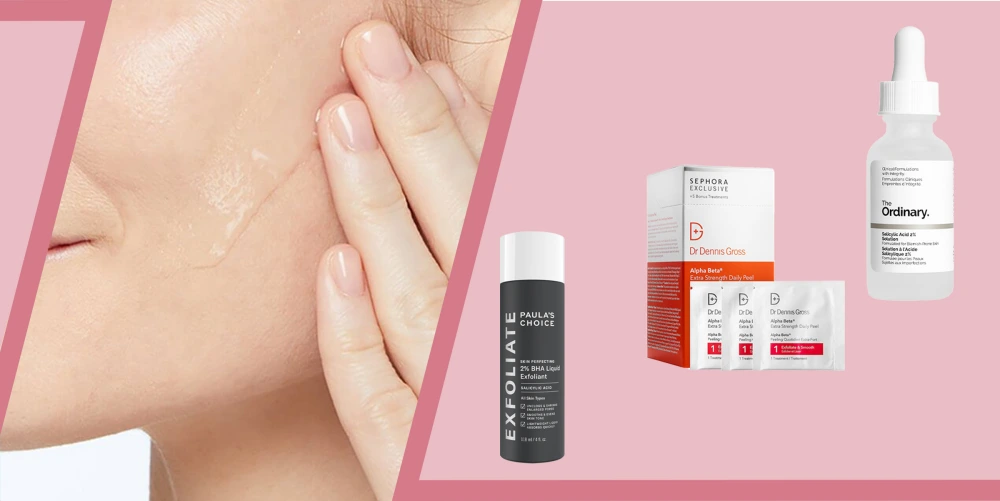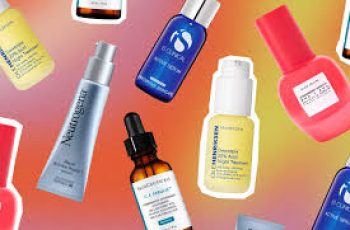**Can You Exfoliate and Use Salicylic Acid Together?**
Salicylic acid is widely celebrated for its powerful ability to clarify the skin, particularly for those who suffer from acne or frequent breakouts. Its reputation as a key skincare ingredient speaks volumes about its effectiveness.
Given how potent salicylic acid is, it’s natural to wonder if adding an exfoliating step to your routine could either enhance or negatively impact the overall health and appearance of your skin. This post aims to explore this question, and hopefully, we’ll provide all the answers you’re looking for regarding exfoliating while using salicylic acid.
For those of you who might be unfamiliar with salicylic acid and how it benefits the skin, we’ve got you covered. If you’re already well-versed in skincare, feel free to skip ahead!
### What Is Salicylic Acid?
Salicylic acid, also known as acne’s worst enemy, belongs to the beta hydroxy acid (BHA) family and is a go-to ingredient for tackling problematic skin prone to breakouts. It works by gently exfoliating the skin’s surface, helping to remove dead skin cells that can clog pores and lead to blemishes like whiteheads and blackheads. Salicylic acid is oil-soluble, which means it can penetrate the skin’s surface and dissolve excess sebum (the natural oils produced by the skin), reaching deep into pores for a thorough cleanse.
Due to its ability to penetrate the skin effectively, salicylic acid is commonly found in a variety of skincare products, from cleansers to serums, and is available in varying strengths, making it accessible for all skin types. However, it’s worth noting that salicylic acid can be drying or irritating for those with sensitive or dry skin, so for these skin types, it’s often better to opt for a gentler formulation like a cleanser or toner, where the concentration is typically lower.
If you’d like to dive deeper into salicylic acid and its benefits, check out our dedicated blog post for more details.
### Do I Need to Exfoliate If I Use Salicylic Acid?
Not necessarily. Salicylic acid itself functions as an exfoliant. Since it’s a chemical exfoliant, it works by loosening and removing dead skin cells, which is essentially the same purpose as physical exfoliants like scrubs. If you’re using salicylic acid in your routine, it’s already providing regular exfoliation, so adding another exfoliating product could potentially irritate your skin.
If you’re keen on using both a salicylic acid product and a physical exfoliant, the key is moderation. You could alternate their use—for example, use a salicylic acid face wash in the morning and reserve your physical scrub for the evening routine. This way, you’re avoiding over-exfoliation and giving your skin a chance to recover.
### Can I Use a Salicylic Acid Cleanser and Exfoliator Together?
It’s best to avoid using both a salicylic acid cleanser and a physical exfoliator in the same routine, as this can lead to excessive dryness and irritation. If you still want to incorporate both into your skincare regimen, I recommend using them on different days or at different times of the day.
Once your skin builds tolerance to salicylic acid, you can safely use it twice daily in your routine, as long as you’re not also applying a face scrub at the same time. If you do use a physical scrub, it’s best to apply it at night when your skin isn’t exposed to environmental stressors like UV rays, pollutants, and other irritants. After exfoliating, follow up with a hydrating serum, like one containing hyaluronic acid, to replenish moisture and soothe the skin.
### Is Salicylic Acid an Exfoliant?
Yes, salicylic acid is indeed an exfoliant. Like other chemical exfoliants such as glycolic acid, lactic acid, and malic acid, salicylic acid helps to slough off dead skin cells without the need for physical scrubbing. Its small molecular structure allows it to penetrate deep into the skin and exfoliate from within the pores—something that physical scrubs can’t achieve.
### What Type of Exfoliator Should I Use?
The right exfoliant depends on your skin type and concerns. Here’s a guide to help you choose the best exfoliator for your skin:
– **Oily Skin:** People with oily skin often struggle with clogged pores and breakouts due to excess sebum production. Both physical exfoliants (like scrubs or cleansing brushes) and chemical exfoliants (like salicylic acid) are great choices for deep exfoliation to combat these issues.
– **Acne-Prone Skin:** If you’re dealing with acne, chemical exfoliants like salicylic acid and glycolic acid are ideal. Avoid aggressive scrubbing, as it can irritate the skin, spread bacteria, and strip the skin of essential oils, which can lead to more breakouts.
– **Dry Skin:** For dry skin, it’s important to choose gentler exfoliants to avoid irritation. Creamier products enriched with mild acids like lactic acid or polyhydroxy acids (PHAs) work well. Physical scrubs with a creamy consistency can also help but should be formulated for dry skin to avoid further dryness.
– **Combination Skin:** Combination skin, which has both oily and dry areas, benefits most from chemical exfoliants like salicylic acid. Physical exfoliants may cause irritation, especially in the drier areas, so it’s best to avoid them.
We hope this post has answered your questions about exfoliating while using salicylic acid. If you have more queries or need further advice, feel free to connect with us on Instagram!
DQH Knowledge drop: In your 20s, your skin cell turnover decreases. (Cell turnover is a key component in keeping your skin youthful.) You know what else slows down? Your collagen production. Starting in your 20s, collagen decreases by about 1 percent per year. Should you want to prevent fine lines and wrinkles, start by eliminating behaviors that contribute to premature aging. “If it’s bad for you, it’s bad for your skin,” says dermatologist Michel Somenek.
“Cigarette smoking reduces blood flow to the skin and causes premature wrinkling and a dull skin texture. Making the repeated pursed motion to inhale can also cause smoker’s lines. Alcohol and recreational drugs are toxins for the skin that damage its cellular structure and DNA,” Somenek tells us. “The faster you eliminate vices while you are young, the better chance your skin and body have to recuperate.” Also, adopting an anti-aging routine in your 20s is key. After all, the best offense is a good defense. We spoke to Somenek and experts Joshua Ross and Audrey Kunin to find out more.
Keep reading for the best anti-aging products for your 20s, according to skincare professionals.
Sunscreen
“We all know that the sun is the number one cause of skin aging and starting the prevention in your 20s is very important,” Ross says. “The majority of your sun damage won’t start to appear until you’re in your 30s, so don’t wait until you see it surface or you’ll be behind the curve. Stay ahead of it with a good-quality zinc-based sunscreen worn daily.”
Farmacy Green Defense Daily Mineral Sunscreen
An invisible sunscreen with SPF 30, plus botanical extracts meant to protect skin with tons of antioxidants. Bonus: It’s clean and fine to use under makeup.
Bareminerals Complexion Rescue™ Tinted Moisturizer Broad Spectrum SPF 30
Although we recommend you use your SPF and moisturizer separately, we also understand moments when you don’t have time or energy for that extra step. For those times, this bareMinerals moisturizer is a great thing to have on hand.
Vitamin C Serum
“A great introduction to anti-aging is to start with a vitamin C serum in your morning skincare routine,” Ross says. “It’s a powerful antioxidant that will neutralize free radicals and brighten the skin.” He adds that it’s a great way to counteract the effects of the sun’s harmful rays, which, as previously mentioned, are among the biggest causes of premature aging.
Drunk Elephant C-Firma™ Vitamin C Day Serum
The Drunk Elephant C-Firma is a lightweight serum that promises to give skin a glow by combining the brightening powers of vitamin C with ferulic acid, l-ascorbic acid, and vitamin E. The included sodium hyaluronate is meant to replace hydration loss, so you shouldn’t have to deal with any irritation.
Sunday Riley C.E.O. Rapid Flash Brightening Serum
This potent serum is jam-packed with vitamin C (15 percent, to be exact), which means it’s a potential superstar at both brightening skin and dousing it in antioxidants.
Peptides
Using peptides on your skin has many benefits, says Somenek. “The skin barrier is what defends the body against pollution, UV rays, bacteria, and toxins. It can be damaged by several everyday factors. Using topical peptides aids in building a stronger barrier,” he says. “Peptides comprise elastic fibers, which are a type of protein. These fibers help to make skin appear taut and firm. Peptides can also help repair damaged skin, relieve inflammation, and even out skin tone. Some peptides can kill acne-causing bacteria that is common in 20-somethings.”
Kunin agrees, saying, “Peptides are an excellent entry point for supporting collagen.” She recommends looking for face and eye treatments that contain these collagen-boosting powerhouses.
Charlotte Tilbury Magic Eye Rescue Cream
This Charlotte Tilbury super-emollient eye cream has a base of coconut oil and shea butter (read: it’s incredibly hydrating). Botanicals plus peptides are meant to help reduce dark circles and boost collagen, respectively.
This creamy moisturizer serves up potent collagen-boosting peptides and pycnogenol, and antioxidant-rich vitamin C. “Instead of sitting on top of the skin, peptides penetrate the outer layer so they go deep. The ‘signals’ they send tell the cells to produce elastin and collagen, which are needed for youthful-looking skin,” explains Somenek.
At-Home Peel Pads
Remember that skin cell turnover fiasco we talked about earlier? One way to help support it is by exfoliating. “Exfoliation is important to help keep skin fresh and luminous,” Kunin says. She recommends using at-home peel pads as an easy and effective way to exfoliate.
“The goal in your 20s is to fight the slowing pace of cell turnover. It is wise to use products that gently exfoliate, yet still remove oil and other impurities. Products that have Alpha Hydroxy Acids (AHA) or Beta Hydroxy Acids (BHA) are a good choice.”
According to Somenek, you should only exfoliate two to three times a week. “People of all ages are guilty of over-exfoliating and that can be too much of a good thing,” he says.
Dermadoctor Kakadu C Intensive Vitamin C Peel Pad
A few swipes of this Derma Doctor powerful peel pad promise to leave your skin glowing and smooth, thanks to the seven (yes, seven) types of chemical exfoliants, including AHA and BHA. It also contains vitamin C via Kakadu plum extract for added brightening and antioxidant protection.
KEY INGREDIENTS Kakadu plum extract is sourced from the Kakadu plum, a fruit grown in northern Australia. It contains vitamin C, which restores the skin’s natural barrier, increases collagen production, and soothes irritation.
Dr. Dennis Gross Skincare Alpha Beta® Universal Daily Peel Pads
These are the gold standard of peel pads, with a cult following and over 900 five-star reviews on Sephora. They’re easy to use and contain a blend of anti-aging exfoliating acids.
Emollient Night Cream
“In your 20s, you need to start upping the hydration in your skincare routine. You may have been cautious of over-moisturizing because of acne in your teens, but as you enter your 20s, your skin transitions and becomes drier,” Ross says. “I recommend an emollient night cream added into your evening skincare regimen.”
“Twenty-somethings need to make sure that they are not using creams that will clog their pores and cause excess oil production,” says Somenek. Opt for non-comedogenic products.
Cerave Skin Renewing Night Cream
One great choice is the CeraVe Skin Renewing Night Cream, which is a non-comedogenic night cream that leaves skin soft and glowy. It combines the moisturizing powers of ceramides and hyaluronic acid.
RoC Retinol Correxion Max Hydration Creme
“The best night cream ingredients contain retinol, benzoyl peroxide, and/or salicylic acid or hyaluronic acid. The goal is to moisturize, yet remove excess oil,” says Somenek. This Roc Retinol Correxion cream fits the bill as it contains both hyaluronic acid and retinol so it promises to moisturize while also being non-comedogenic.



